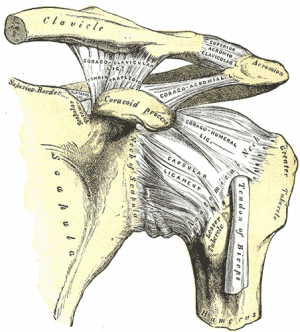Scapulothoracic Posture and Its Effect on GH Instability: Difference between revisions
No edit summary |
No edit summary |
||
| Line 14: | Line 14: | ||
== General features of the scapulothoracic joint. == | == General features of the scapulothoracic joint. == | ||
[[File: | [[File:File.jpg]] | ||
Sub Heading 3 | Sub Heading 3 | ||
Revision as of 18:11, 19 February 2020
Original Editor - Your name will be added here if you created the original content for this page.
Top Contributors - Abdelrahman Elaraby and Kim Jackson
Introduction[edit | edit source]
The shoulder complex is a set of 5 highly mobile and stable mechanically interrelated articulations controlled by groups of synergistic muscles found in the proximal part of the upper extremity, attached to the axial skeleton. So it is, structurally and functionally, the base of the upper extremity. Therefore, once it is affected, the whole upper limb will be affected.
The shoulder complex is highly mobile to help the upper extremity and its distal outstanding part; that is the hand, to perform its function which is embracing the whole world around the human as it is stated by many bio-mechanists. But to be highly mobile and in the same time functional, stability must be an integral factor of the whole equation.
The Glenohumeral joint is a synovial ball and socket joint. Nevertheless, in fact, the glenoid cavity is not deep to be described as a congruent socket which can embrace the humeral head, and it is better to just describe it as a golf ball pressed against a coin; the size of a quarter. This incongruent osteologic structure provides the GH with great mobility to the advantage of its stability, so its always phrased that the GH joint favors mobility rather than stability. However, there are many mechanisms and structures either passive or active to maintain the stability of the joint in both the dynamic and static situations. And the scapular position is considered one of the most important mechanism helping the GH remain stable as possible.
General features of the scapulothoracic joint.[edit | edit source]
Sub Heading 3
References[edit | edit source]
1. Neumann, Donald A. Kinesiology Of the Musculoskeletal System : Foundations for Physical Rehabilitation. St. Louis :Mosby, 2002
2. Basmajian JV, Bazant FJ: Factors preventing downward dislocation of the adducted shoulder joint. JBone Joint Surg Am 41:1182–1186, 1959.
3. Itoi E, Berglund LJ, Grabowski JJ, et al: Superiorinferior stability of the shoulder: role of the coracohumeral ligament and the rotator interval capsule.Mayo Clin Proc 73:508–515, 1998.
4. Itoi E, Motzkin NE, Morrey BF, et al: Bulk effect of rotator cuff on inferior glenohumeral stability as function of scapular inclination angle: a cadaver study. Tohoku J Exp Med 171:267–276, 1993.








